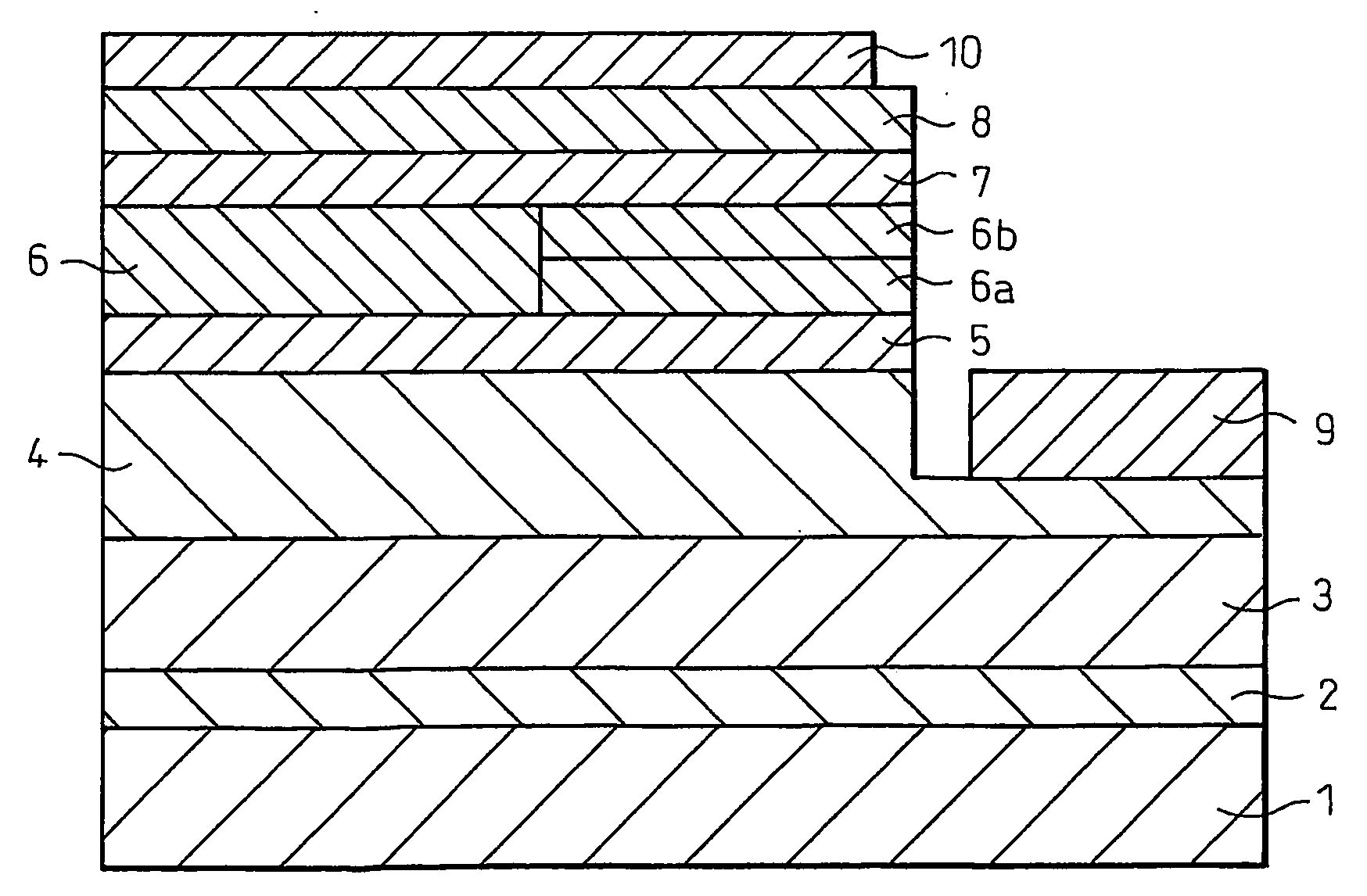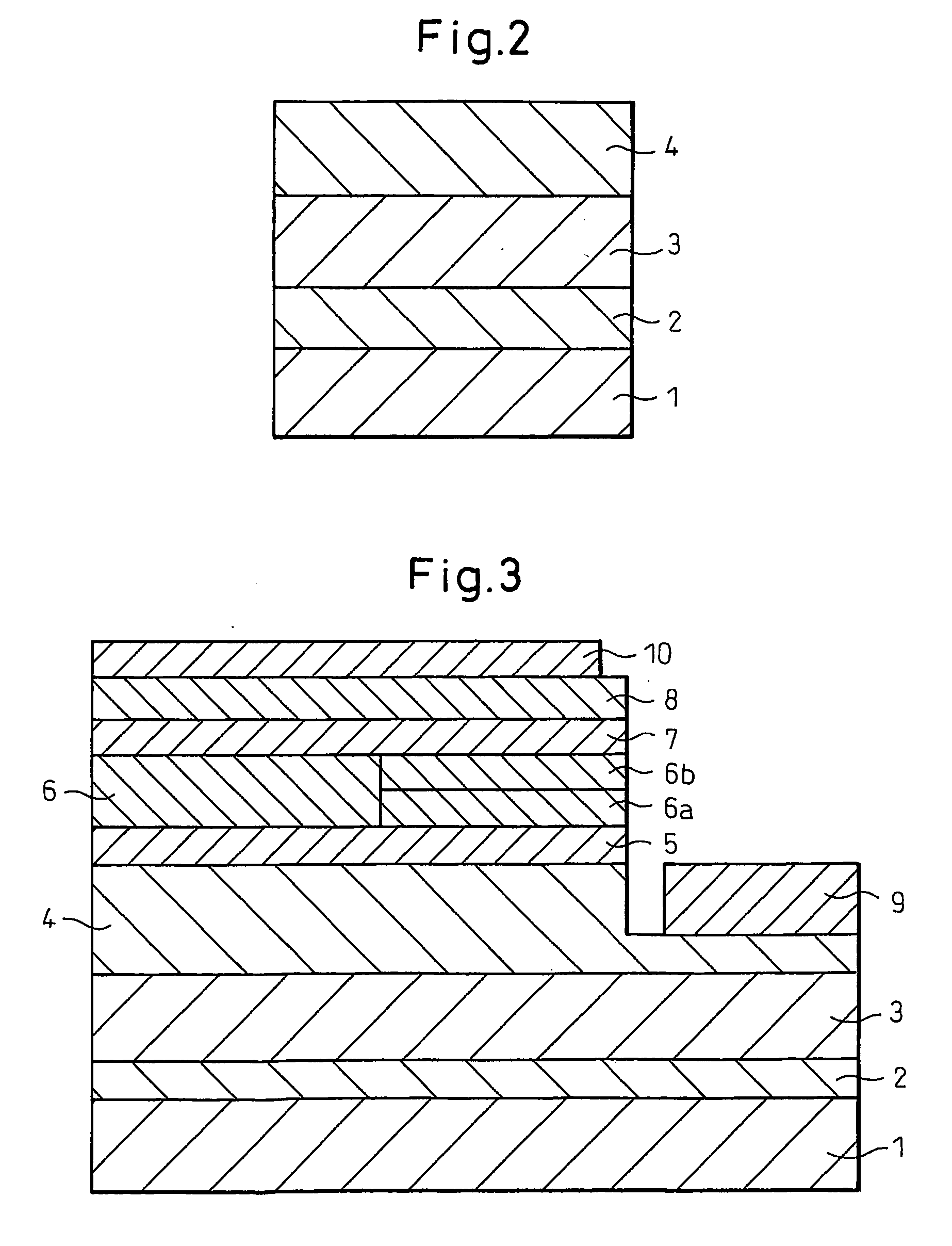N-Type Group III Nitride Semiconductor Layered Structure
a layered structure and nitride technology, applied in semiconductor/solid-state device manufacturing, semiconductor devices, electrical equipment, etc., can solve the problems of low resistance and continuous nitride semiconductor layers that have not been reliably obtained, emission intensity is lowered after aging, and the layer is prone to cracks. , to achieve the effect of low forward voltage, low resistance and high flatness
- Summary
- Abstract
- Description
- Claims
- Application Information
AI Technical Summary
Benefits of technology
Problems solved by technology
Method used
Image
Examples
example 1
[0078]FIG. 2 schematically shows a cross-section of a stacked structure containing a Ge-doped n-type Group III nitride semiconductor layer fabricated in Example 1.
[0079]A stacked structure including a sapphire substrate and Group III nitride semiconductor layers successively stacked on the substrate was formed by means of conventional reduced-pressure MOCVD through the following procedure. Firstly, a (0001)-sapphire substrate 1 was placed on a high-purity graphite (for semiconductor) susceptor to be heated at a film formation temperature by a high-frequency (RF) induction heater. The sapphire substrate placed on the susceptor was placed in a stainless steel-made vapor growth reactor furnace, and the reactor furnace was purged with nitrogen.
[0080]After passage of nitrogen in the vapor growth reactor furnace for 8 minutes, the substrate 1 was heated over 10 minutes from room temperature to 600° C. by means of the induction heater. While the substrate 1 was maintained at 600° C., hydro...
example 2
[0088]The procedure of Example 1 was repeated, except that a plane direction of a surface of a sapphire substrate was inclined from a direction to a direction (an inclination angle: 0.35 degree), to thereby form a stacked structure.
[0089]The Ge-doped n-type GaN layer 4 of the thus-produced stacked structure was found to have a carrier concentration, as measured on the basis of Hall effect, of 7×1018 cm−3, which is equivalent to that obtained in Example 1. The n-type GaN layer 4 had a remarkably flat surface having a pit density of 180 / cm2 or less. Also, a sample separately taken out from the furnace after the growth of the higher concentration layer was observed under an atomic force microscope. As a result, it was found that the density of pits produced on the surface of the higher concentration layer was 1×107 / cm2.
example 3
[0090]The procedure of Example 1 was repeated, except that a Ge-doped n-type GaN layer 4 having a thickness of 2.0 μm was formed through supplying (CH3)4Ge for 9 seconds, followed by stopping supply for 9 seconds, and repeating the cycle 200 times, to thereby form a stacked structure.
[0091]The Ge-doped n-type GaN layer 4 of the thus-produced stacked structure was found to have a carrier concentration, as measured on the basis of Hall effect, of 7×1018 cm−3, which is equivalent to that obtained in Example 1. Through SIMS analysis, each higher concentration layer was found to have a Ge atom concentration of 1.2×1019 cm−3 and a thickness of 5 nm, and each lower concentration layer was found to have a Ge atom concentration of 1×1018 cm−3 and a thickness of 5 nm. The n-type GaN layer 4 had a surface having a pit density of 4,000 / cm2. Although the pit density is slightly higher than that obtained in Example 1, the surface was very flat as compared with a conventional Ge-doped n-type semic...
PUM
| Property | Measurement | Unit |
|---|---|---|
| Ra | aaaaa | aaaaa |
| thickness | aaaaa | aaaaa |
| thickness | aaaaa | aaaaa |
Abstract
Description
Claims
Application Information
 Login to View More
Login to View More - R&D
- Intellectual Property
- Life Sciences
- Materials
- Tech Scout
- Unparalleled Data Quality
- Higher Quality Content
- 60% Fewer Hallucinations
Browse by: Latest US Patents, China's latest patents, Technical Efficacy Thesaurus, Application Domain, Technology Topic, Popular Technical Reports.
© 2025 PatSnap. All rights reserved.Legal|Privacy policy|Modern Slavery Act Transparency Statement|Sitemap|About US| Contact US: help@patsnap.com



